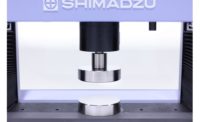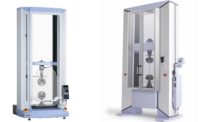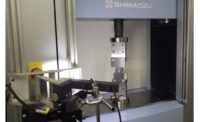Back to Basics: Tensile Testing for Rigid Plastics

Regular tensile testing is important for checking rigid plastics through the entire manufacturing cycle, from the raw material to the forming process and ultimately the production part.
“From a quality standpoint, one of the ways you check your process stability is through routine tests, day-in and day-out, with every batch of material you make,” says Steve Driscoll, professor, department of plastics engineering, University of Massachusetts Lowell. “For the producers using the material, it’s the same situation. You are looking at, what happens if your process goes out of whack? What happens if, for some reason, you have a temperature control that’s not working properly—be it an extrusion operation or a blow-molding operation or an injection-molding operation? So by looking at various physical properties, you get a better idea of how robust your process is.
“For the design engineer, the person who’s selecting the right material for the right application, again tensile properties is just one of those prime indicators of the strength of the material.”
For the resin suppliers and the part makers, the practical applications for tensile testing are as vast as the number of plastic components used in aerospace and automotive manufacturing.
“You have to have a way of internally checking the quality controls of the products you’re making,” Driscoll explains. “So that could be anything from a body panel on a car, or an interior component of a car. It could be taillights; it could be instrument panel characteristics. It could be something like the wiring cable that’s used in a car.”
Standards
ISO, JIS and ASTM provide standards for tensile testing, but the focus here will be ASTM D638. It’s one of the older test methods on ASTM Committee D20’s books, dating to the mid-20th century. Like all ASTM standards, it’s reviewed every five years to address any questions posed by recent advancements in materials or technologies. Driscoll notes that every few years ASTM organizes a round-robin quality control test, in which the organization recruits a facility to fabricate more than a thousand identical test specimens for distribution to subscribing labs.
“This gives the individual laboratory a pretty good handle on if they are in the ballpark with everybody else,” he says. “And it also gives a good indication of the true ruggedness of the ASTM tests.”
The standard itself requires that the force measurement device in use have an accuracy of ±1% and be verified according to ASTM E4 procedures. It also requires an extension measurement device that meets or exceeds class B-2 for elastic modulus measurements; class C for yield strength measurements and an error less than ±10% for high extension measurements above 20% strain, according to ASTM information provided by Shimadzu. Typically, a class B2 extensometer is used in conjunction with the loading frames internal displacement measuring device to acquire the full range of tensile properties.
What to Consider Before Buying Tensile Testing Instruments
Many factors should be weighed before selecting the right tool for the job. Often, the considerations will relate to the method being followed and the specimens being tested. Does the job call for a floor model or a tabletop model? What type of jig is required? Experts at Shimadzu also note that, relative to ASTM D638, the test frames and load cells must meet the test force accuracy requirements, and the extensometer must be compliant with the method.
How a Tensile Test Works
First, the specimen must be fabricated to the correct geometric specification for the material in question, as prescribed by ASTM. Assuming all is correct, the specimen, or “dog bone,” due to its shape, is clamped in the universal testing machine. This procedure requires the right type of grips that grab properly and prevent any slippage. The machine then pulls or stretches the test specimen at a fixed speed. The strain rate of the crosshead, or the testing speed, is again specified by ASTM depending on the material. As the material stretches, an extensometer—or strain gage—measures the deformation within a one-inch separation. A traditional extensometer clamps in the middle of the “dog bone.” There are also non-touch optical extensometers, as well—typically two cameras focused on grids stamped on the test section of the specimen. Regardless of the gage method used, the change in length, divided by the original length, is the strain measurement, or deformation. The strain is then used to calculate the modulus, which is found by dividing the stress—or how much force is required—by the strain.
“The idea is you want to measure, very carefully, the deformation that is the extension of the material in tension,” Driscoll explains. “And modulus is synonymous with the functional stiffness, or functional rigidity, of the material.”
After the test, a typical data sheet will list yield behavior, as well as the modulus. Performing a test until specimen failure is less common, and therefore so is the reporting of elongation-at-break data.
Inconsistent Data
With so many factors at play, from the original resin creation to part fabrication, preparation of the specimen, or various lab errors or failures in following ASTM specifications, it’s not wholly unusual for two labs to find different results for the same material. An effective way of settling these disputes is to eliminate as many factors as possible, and then cross-check the results.
“If I had a customer complaining that he’s not getting the functional properties that I promised, what I’d say is you should mold some specimens and test them in your lab, and then visit your customer and have your customer test your specimens in his lab,” says Driscoll. “And at the same time, ask your customer for samples he’s molded in his facility and tested, and bring them back to your lab.
“It could be the same material in both lab, but it might be your mold design vs. his mold design, your processing equipment vs. his, your testing equipment vs. his testing equipment. There are so many different variables. That’s why ASTM goes out of its way to have one company generously mold 1,000 specimens as part of its continuous monitoring of the test protocols.”
Looking for a reprint of this article?
From high-res PDFs to custom plaques, order your copy today!







